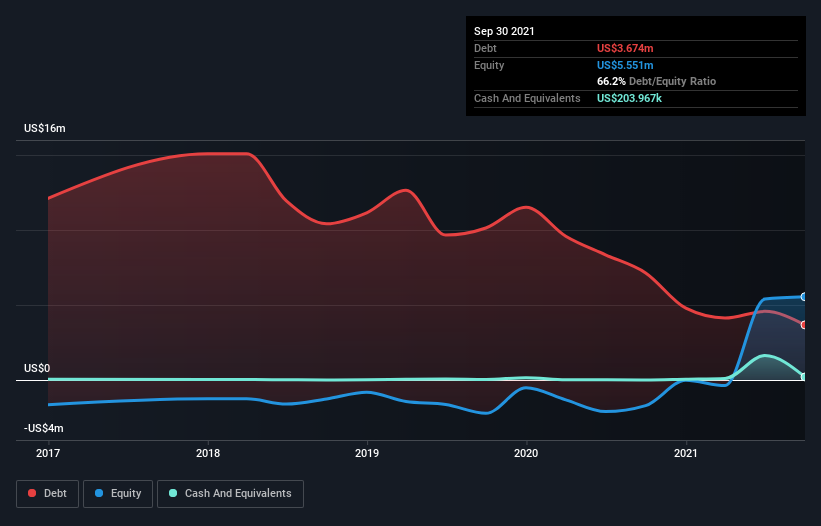
The external fund manager backed by Berkshire Hathaway's Charlie Munger, Li Lu, makes no bones about it when he says 'The biggest investment risk is not the volatility of prices, but whether you will suffer a permanent loss of capital.' When we think about how risky a company is, we always like to look at its use of debt, since debt overload can lead to ruin. We can see that Blue Star Foods Corp. (NASDAQ:BSFC) does use debt in its business. But the more important question is: how much risk is that debt creating?
Why Does Debt Bring Risk?
Debt is a tool to help businesses grow, but if a business is incapable of paying off its lenders, then it exists at their mercy. Part and parcel of capitalism is the process of 'creative destruction' where failed businesses are mercilessly liquidated by their bankers. However, a more usual (but still expensive) situation is where a company must dilute shareholders at a cheap share price simply to get debt under control. Having said that, the most common situation is where a company manages its debt reasonably well - and to its own advantage. When we examine debt levels, we first consider both cash and debt levels, together.
View our latest analysis for Blue Star Foods
What Is Blue Star Foods's Net Debt?
As you can see below, Blue Star Foods had US$3.67m of debt at September 2021, down from US$7.14m a year prior. However, because it has a cash reserve of US$204.0k, its net debt is less, at about US$3.47m.

How Healthy Is Blue Star Foods' Balance Sheet?
Zooming in on the latest balance sheet data, we can see that Blue Star Foods had liabilities of US$5.84m due within 12 months and liabilities of US$514.7k due beyond that. Offsetting this, it had US$204.0k in cash and US$754.8k in receivables that were due within 12 months. So its liabilities total US$5.40m more than the combination of its cash and short-term receivables.
Of course, Blue Star Foods has a market capitalization of US$71.2m, so these liabilities are probably manageable. However, we do think it is worth keeping an eye on its balance sheet strength, as it may change over time. When analysing debt levels, the balance sheet is the obvious place to start. But it is future earnings, more than anything, that will determine Blue Star Foods's ability to maintain a healthy balance sheet going forward. So if you're focused on the future you can check out this free report showing analyst profit forecasts.
Over 12 months, Blue Star Foods made a loss at the EBIT level, and saw its revenue drop to US$11m, which is a fall of 32%. To be frank that doesn't bode well.
Caveat Emptor
Not only did Blue Star Foods's revenue slip over the last twelve months, but it also produced negative earnings before interest and tax (EBIT). Indeed, it lost US$1.6m at the EBIT level. Considering that alongside the liabilities mentioned above does not give us much confidence that company should be using so much debt. So we think its balance sheet is a little strained, though not beyond repair. Another cause for caution is that is bled US$435k in negative free cash flow over the last twelve months. So suffice it to say we do consider the stock to be risky. There's no doubt that we learn most about debt from the balance sheet. But ultimately, every company can contain risks that exist outside of the balance sheet. Be aware that Blue Star Foods is showing 5 warning signs in our investment analysis , and 2 of those shouldn't be ignored...
If, after all that, you're more interested in a fast growing company with a rock-solid balance sheet, then check out our list of net cash growth stocks without delay.
Valuation is complex, but we're here to simplify it.
Discover if Blue Star Foods might be undervalued or overvalued with our detailed analysis, featuring fair value estimates, potential risks, dividends, insider trades, and its financial condition.
Access Free AnalysisHave feedback on this article? Concerned about the content? Get in touch with us directly. Alternatively, email editorial-team (at) simplywallst.com.
This article by Simply Wall St is general in nature. We provide commentary based on historical data and analyst forecasts only using an unbiased methodology and our articles are not intended to be financial advice. It does not constitute a recommendation to buy or sell any stock, and does not take account of your objectives, or your financial situation. We aim to bring you long-term focused analysis driven by fundamental data. Note that our analysis may not factor in the latest price-sensitive company announcements or qualitative material. Simply Wall St has no position in any stocks mentioned.
About OTCPK:BSFC
Blue Star Foods
Through its subsidiaries, operates as a marine protein company in the United States and Canada.
Moderate with adequate balance sheet.
Similar Companies
Market Insights
Community Narratives



